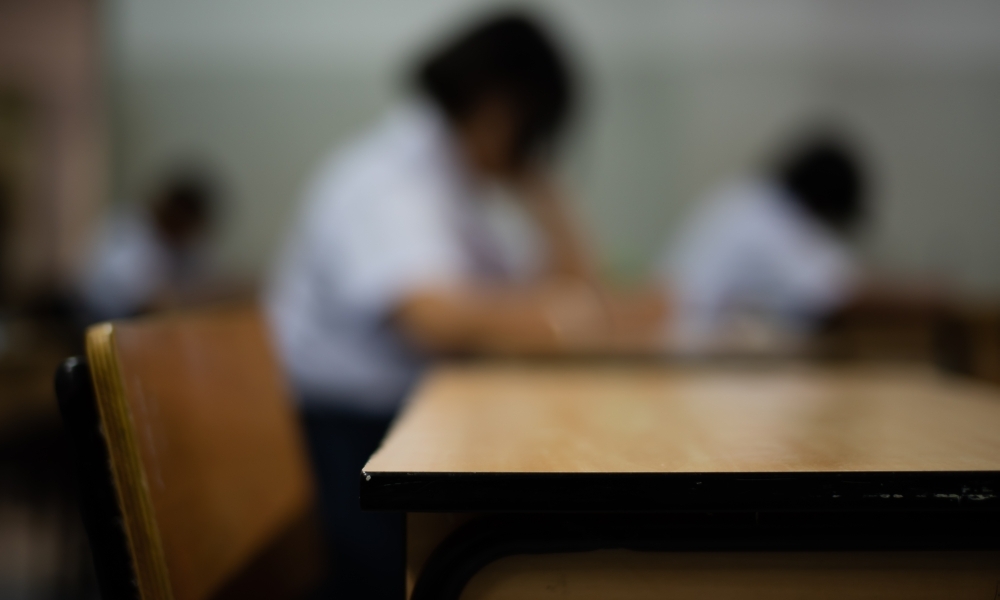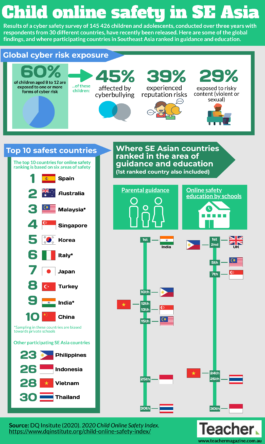In a recent article we looked at how students in Southeast Asia performed in the latest cycle of the Trends in International Mathematics and Science Study. In this follow-up we dig into the accompanying questionnaire findings to gain insights into school discipline and safety, teacher professional development needs, and challenges to teaching and learning in each country.
Every four years, TIMSS assesses student achievement in maths and science at Grade 4 and Grade 8. But it also collects information about the home, school and classroom contexts for learning in these two subjects through questionnaires completed by students, parents and carers, teachers and school leaders.
The three countries in the region that participated in the latest cycle of TIMSS were Singapore, Malaysia and the Philippines. As discussed in the previous article, Singapore topped the country rankings for student achievement in all four assessments. The Philippines participated in the Grade 4 maths and science tests, coming bottom of the rankings in both. Malaysia participated in the two Grade 8 assessments, ranking 28th in maths and 29th in science.
Parent satisfaction
In TIMSS 2019, parents and carers of Grade 4 students were asked for their perceptions about their child’s school – including, promotion of high academic standards, providing a safe environment, informing parents about their child’s progress, and caring about their child’s progress. Interestingly, parent satisfaction with their child’s school was higher in the Philippines than in Singapore, where three quarters (75 per cent) were ‘very satisfied’ and 23 per cent ‘somewhat satisfied’ compared to 63 per cent and 33 per cent, respectively.
School discipline and safety
The TIMSS 2019 questionnaire measured principals’ perceptions about the extent to which ‘discipline, disorder, and bullying behaviours are problems in their school’. The 10 statements included issues such as absenteeism, arriving late at school, cheating and physical injury to students. The Grade 8 questionnaire included an extra item – physical injury to teachers or staff.
Based on these principal reports, 44 per cent of Grade 4 students in the Philippines were in schools with ‘hardly any problems’, just over half (52 per cent) were in schools with ‘minor problems’ and 4 per cent attended schools with ‘moderate to severe problems’. In Singapore, around three quarters of students (76 per cent) were in schools with ‘hardly any problems’ and the remaining 24 per cent were in schools with ‘minor problems’ – for Grade 8 the percentages were 70 and 30, respectively. In Malaysia, 45 per cent of students in Grade 8 attended schools with ‘hardly any problems’, 49 per cent were in schools with ‘minor problems’ and 6 per cent were in schools with ‘moderate to severe problems’.
Meanwhile, the teacher questionnaire sought responses to eight statements about safety and order at their school. According to these reports, 70 per cent of Grade 4 maths students in the Philippines (rising to 77 per cent for science) and 68 per cent in Singapore (67 per cent for science) were in schools that were ‘very safe and orderly’. For Grade 8 science students in Singapore it was a similar result (68 per cent) but the percentage dropped to 58 for maths. By contrast, teacher reports indicate less than one third of Grade 8 maths (30 per cent) and science (32 per cent) students in Malaysia attend schools that are ‘very safe and orderly’.
And students were asked about 11 bullying behaviours. At Grade 4, 45 per cent of students in the Philippines reported being bullied ‘about weekly’, compared to 7 per cent in Singapore; while 16 per cent of Grade 8 students in Malaysia reported being bullied ‘about weekly’, compared to 5 per cent in Singapore. In all cases, students who reported being bullied ‘about weekly’ achieved lower test scores, on average, than those who reported being bullied ‘never or almost never’. For example: in the Philippines 351 points compared to 269 points for Grade 4 maths; in Malaysia 476 points compared to 439 points for Grade 8 science; and in Singapore, 638 points compared to 569 points in Grade 4 maths.
Teacher professional development needs
In the questionnaire, teachers were asked about their needs for future professional development. The TIMSS 2019 report reveals: ‘On average across countries, professional development related to integrating technology into instruction and improving students’ critical thinking skills were the two areas of need most commonly reported by mathematics and science teachers in the fourth and eighth grades.’
This was also the case in the Philippines, Malaysia and Singapore. For Grade 4 teachers in the Philippines, professional development related to subject content and addressing individual student needs were also particular areas of concern.
Challenges to teaching and learning
One of the challenges to teaching and learning explored in the questionnaire is student absenteeism. The TIMSS report notes: ‘Because coming to school is the foundation for having an opportunity to learn, it is not surprising that an increase in frequency of being absent is highly related to a decrease in average achievement, especially for students absent “once every two weeks” or more.’
Results in this section are based on student reports. In Singapore, 2 per cent of Grade 4 students and 3 per cent of Grade 8 students were absent ‘once every two weeks’. In the Philippines, 13 per cent of Grade 4 students reported being absent ‘once every two weeks’ and around one third (32 per cent) ‘once a week’. In Malaysia, 10 per cent of Grade 8s reported being absent ‘once every two weeks’ and 17 per cent ‘once a week’.
The full TIMSS report (https://timssandpirls.bc.edu/timss2019/) has detailed information about each country’s performance (including achievement by gender, descriptions of each benchmark and example items from the test) and the parent, student, teacher and principal questionnaire results.
References
Mullis, I. V. S., Martin, M. O., Foy, P., Kelly, D. L., & Fishbein, B. (2020). TIMSS 2019 International Results in Mathematics and Science. Retrieved from Boston College, TIMSS & PIRLS International Study Center website https://timssandpirls.bc.edu/timss2019/international-results/
As a school leader, what are the professional development needs of your teachers?
As a teacher, do you know your class or whole school attendance rate? Do your students know their own attendance rate?
As a school leader, what strategies do you have in place to improve student attendance?



